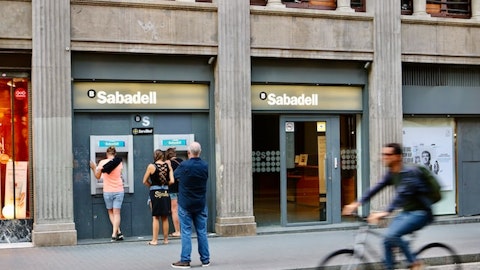Banco Bradesco S.A. (NYSE:BBD) Q2 2023 Earnings Call Transcript August 4, 2023
Carlos Firetti: Hello, good morning everyone. Welcome to our Second Quarter 2023 Earnings Video Conference. Thank you very much for your participation. In the opening part of the event, our President, Octavio will present the Bank’s results. Then, we will have the question-and-answer session. The presentation and other materials are available for download on our Investor Relations’ website. [Operator Instructions] The presentation will be in Portuguese with simultaneous interpretation into English. Audio language can be selected directly from the window you are watching. You can also choose audio always in Portuguese even when questions are asked in English. And now I’ll turn the floor over to Octavio, who will begin our presentation of results. We’ll meet again later in the Q&A section, see you soon.
Octavio de Lazari: Thank you, Firetti. Good day everyone. Thank you for joining us on our earnings video conference. We start our presentation with highlights for the period. Net income for the second quarter of 2023 was R$4.5 billion, a rise of 5.6% versus the previous quarter, within our expectations. As we’ve stated over the past few quarters, the recovery process will be gradual. Our Basel ratio posted a 34 bps boost in Tier 1 capital, even with the full constitution of IoC. Market NII improved even further and will continue to progress over the next half year and in 2024. Client NII, however, is impacted by the momentary lower origination and lower risk mix. The bank’s performance is pressured by credit provisions expenses.
On the other hand, we’ve been able to control NPLs with an improvement in the 15 to 90-day index as a result of the adjustments in credit policies that we have made over the last few quarters. New vintages demonstrate an improvement in quality, and this has allowed an initial resumption of origination, primarily in personal loans for middle-income individuals and a good pipeline in the wholesale bank for the second half. This resumption will continue over the coming quarters, expanding to other credit lines as well as to retail. The Insurance Group, again, saw a growth results in the income. We see strong momentum for the insurance business, contributing positively to the group’s performance this year, with a counter-cyclical effect. We continue with our strategic and efficiency initiatives, the key ones being the reduction of the cost-to-serve in retail, strengthening our high-income operation and the bank’s digital transformation.
Our primary focus is on serving our 72 million clients even better, placing them at the center of everything we do. Our work, centered on providing excellent service to our clients, is geared towards contributing to their achievements. We have evolved and customized the journeys, processes and products according to the demand, the need and desires of our clients. We’ve felt the recognition of our over 38 million account holders, through significant progress seen in the NPS for individual retail and prime in a variety of products. We will continue to strive for constant improvement in an effort to provide our clients. Speaking of our digital agenda, Bradesco has always been noteworthy for its pioneering spirit in innovation. Our ecosystem of innovation links agile work methodologies, tools and collaboration with suppliers and start-ups.
I would also like to point out, the partnerships with significant and renowned institutions throughout Brazil and abroad, with which we have participated in a number of different projects, in addition to the search for highly qualified professionals, particularly data scientists and in technology to join our staff. We are continually promoting, the digital mindset and innovation culture across the bank. This facilitates new business, scalability and personalization of services for clients. The accelerated use of the cloud, coupled with the emerging agile methodologies in the work, has enabled a continuous reduction in the timescales for new implementations. BIA, the artificial intelligence application we pioneered, has had more than 2 billion client interactions since its introduction.
In addition, we are exploring and using new technologies such as generative AI and Quantum Computing also in finance [indiscernible] at various stages of our clients’ journey. The clients profile has rapidly evolved, as they have become increasingly digital each day. Nowadays, 73% of our clients have a digital behavior and 98% of all transactions are performed through self-service channels. The volume of financial transactions on mobile devices has continued this trend and has grown by 33% year-to-date compared to 2022. As part of our efforts to optimize the cost-to-serve, Bradesco Expresso plays a very important role. There are more than 41,000 service points throughout the country, offering convenience to our clients through a variable cost network.
In addition, we promoted the integration of Next with Bradesco. In this new context, Next clients will have complete access to Bradesco’s complete portfolio of products and services. Digio continues as a separate digital bank, focused on cards, payment accounts and partnerships. Still in the digital evolutions, we launched e-agro, an innovative digital platform for specialized services intended for rural producers that combines financial and non-financial products and services in an effort to address all our clients’ needs. This robust ecosystem features partners that carry the best offers to the market, covering the entire agro chain, from financed costs to the sale of grains. Anchored in artificial intelligence, the platform is capable of making proactive recommendations for offers and services, and also helps rural farmer purchase financed products and get credit – for 100% online.
We have witnessed a growth of 115% in this segment over the last four years, and we are the largest private bank operating in Agribusiness, boasting unique and specialized services, with 14 agribusiness platforms that have dedicated teams, including agronomists. We have continued to improve our wealth services, a line of business that has been one of our top strategic priorities. And our combined investment platforms, which also include our local banks in the United States and Europe, have now received yet another addition – Tivio Capital. This investments manager, established in partnership with BV, it has R$ 42 billion under management and will continue to act independently and specialize in managing high value-added structured funds in an open architecture format.
In order to expand our international offer, we launched My Account in July. This is an international digital account for all the publics, and includes a personalized debit card, which can be used to make withdrawals and purchases in over 200 countries with automatic currency conversion. It’s a practical and tailored solution, which joins the Bradesco Bank offer. And lastly, before presenting our financial performance, we would like to underline our position in sustainability, which permeates our strategy and our businesses. We have now reached 78% of our goal to allocate R$ 250 billion to sustainable businesses by 2025, and we also remain committed to creating operations, and products with a positive social and environmental impact, boasting growth, for example, of 72% in financing for the purchase of solar panels and 168% in financing of hybrid and electric vehicles over the last two years.

Copyright: kritchanut / 123RF Stock Photo
Over the course of the last six months, we received a number of different recognitions, such as the inclusion of the funds managed by Bradesco asset as one of the most profitable in the Valor Econômico Fund Guide in partnership with Getulio Vargas Foundation and, within our innovation ecosystem, major awards for payment initiator and Inovabra. Now let’s take a look at the figures for the second quarter. Net Income for the quarter was R$4.5 billion, improving 5.6%. Income from Insurance posted the most relevant positive contribution for the quarter as a result of a solid operational performance, including improvements in the claims ratio. Market NII has been following the path of recovery that we had predicted, making a positive contribution.
Client NII had a negative impact, as did credit provision. We’ll show additional details on the upcoming slides. Now we’re going to address our credit portfolio. It grew 1.6% year-on-year and fell 1.2% over the quarter. This performance reflects the ongoing restricted demand in light of interest rate levels, and the adjustments we made to our credit policy in some portfolios, mainly in higher-risk segments, like lower-income individuals and micro and small companies. In Individuals, we would like to point out the growth in real estate financing mortgage and cards, concentrated in high income. For corporates, we highlight rural credit [ph]. We have begun to gradually increase origination in some segments this quarter, and we intend to continue to do so over the second half of the year, assuming that the vintages maintain the positive performance we have witnessed to-date.
As for guidance, considering the dynamics up to now, we opted to revise the growth indication, which now ranges from 1% to 5%. As we mentioned before, the new vintages have demonstrated an improved performance. The level of delay over 30 days four months after granting credits, the so-called mob4, is now almost 50% better than it was in December 2021. This has helped contain NPLs, and has allowed us to expand origination in some products and segments. Credits originated from 2022 onwards, when we started adjusting our credit policies, now represent 53% of the portfolio and are, for the most part, a profile of lower risk. For example, secured loans represent 68% of new vintages for individuals. We saw R$ 10.3 billion in credit provision expenses over the quarter, representing a cost of risk of 4.8%.
In this first six months, the actual is 52%, 52% of what I indicated in the center of the guidance, which ranges from R$ 36.5 to R$ 39.5 billion. We believe that the guidance remains valid, although the annualized value points to the upper portion at this time. Still on credit provision, the balance reached R$ 60.2 billion, representing 9.6% of the credit portfolio. Over the quarter, we once again posted a lower level of credit provision expenses under IFRS 9, which reflects expected losses. The NPL creation over the quarter came to R$ 11.6 billion, excluding the specific client effect. The still high level reflects the performance of older vintages. When we analyze coverage over the second quarter of 2023, and that’s why we’ll break it down by months.
We see some stability in these indicators. We emphasize the coverage excluding 100% provisioned credits, which is 244%. Exceptionally this quarter, we present the monthly delinquency, as this provides a clearer view of this indicator’s stabilizing trend. The short-term NPL showed some improvement in all segments and, in the graph for the over 90-day ratio, it is now possible to see the inflection of the curves, even with the unfavorable denominator effect caused by the shrinking of the credit portfolio. I would also like to highlight the disclosure of our NPL ratios without the impact of that specific client. Now on to the net interest income. The total NII was R$ 16.6 billion in this quarter. Market NII posted a new evolution compared to the previous quarter and this line will continue to gradually improve, with the recovery of the bank’s ALM.
Clients NII dropped by 1.7% on an annual basis, reflecting the reduced volume and the 20 bps fall in the spread, which stood at 9.7%, due to the lower risk origination mix. We have revised our projections for total NII, considering the trend we see for the rest of the year. The new guidance range includes growth between 2% and 6%. Fees line is a challenge for the entire market, and it’s no different for us. Cards income continued to perform well, driven by higher spending by our middle and high income clients, groups in which we have recently increased penetration. For asset management, we are also adjusting our products and client offers and are already seeing signs of improvement. The other lines continue to be pressured by regulatory issues and the market’s momentum.
In this quarter, we had significant revenues in capital market operations and we expect that these revenues, may be even more relevant in the second half of the year. We closed the first six months below the guidance floor, but we expect an improvement over the second half of the year, and so we have kept the expectation for this line with an indication more towards the floor of this projection. Costs grew 11% year-to-date. Personnel expenses rose by 7.6%, driven by the last year collective agreement. Administrative expenses expanded 4.0%. The biggest impact on costs as we have most of the incomes from the other expenses and revenues line, due to the lowest comparison base in 2022. We continue with tight control in expenses, adjusting our operation, structures and the cost-to-serve to allow better results without impacting customer service.
If, on the one hand, we adjusted our guidance for credit growth and, consequently, for NII, on the other hand, we are improving the guidance for operating expenses and insurance income, as we will discuss later. The guidance for expenses, which was close from 9% to 13%, now ranges from 7% to 11%, reflecting our efficiency and control actions. In the Insurance Group, our performance continues to evolve. Net income for the quarter was R$ 2.4 billion, an increase of around 30% in quarterly and annual comparisons. The premiums growth and the improvement in claims ratios allow for a strong evolution on the operational side. The performance of the financial results was also positive. Income from operations is up 21.7% year-to-date. And given this scenario, we revised the expectation for the year, which now ranges from 21% to 25%.
Finally, we’ll talk about capital and IoC. The Tier 1 capital ratio grew by 34 bps to 12.9%, primarily benefited by the cumulative profit for the period. The provisioned amount for interest on equity accumulated in the first half of the year posted a potential payout of 69% for the period. Our liquidity position also remains quite comfortable, with LCR at 178%. I’m going to finish up the presentation and before moving on to the Q&A session. I’d like to point out that the revisions, we’ve made to our projections reflect the operating dynamics we’ve seen up to this point. We know that we have important challenges in translating our commitment into better results and, therefore, you can be sure that we are committed to delivering a better performance every quarter.
Now, I’ll join Cassiano and Firetti for the Q&A session. Thank you.
See also 12 Best Aerospace and Defense Stocks to Buy and 12 Best Robotics Stocks To Buy Now.
Q&A Session
Follow Banco Bradesco S A (NYSE:BBD)
Follow Banco Bradesco S A (NYSE:BBD)
Operator: We will begin the Q&A session we have Otavio and Casciano, our CFO. We also have the President of the Insurance group Ivan Contijo who connected through – by voice. You can ask questions in Portuguese or English. And the answer will always be in Portugese. You have an option for simultaneous interpreting of questions in English into Portuguese. The recording will be available on our Investor Relations website. With that shall we begin? The first question from Yuri Fernandes with JPMorgan.
Yuri Fernandes: Thank you, Firetti and Octavio. The first, please I’d like to understand the trajectory of credit provisions for 2024. I think it’s clear what you mentioned in the presentation that it would be close to the top of the guidance. And there’s a positive message in NPL. So I’d like to check if this is your opinion indeed. But my question is for 2024, there is an expected loss. So as you grow origination, my doubt is whether if the growth of your originations will not increase ALL or credit provision? So if we have a peak of NPL, I’d like to understand the bank’s vision or opinion for the next year in terms of credit provision curve. And the second question regarding interest rate sensitivity. In the past, you would show sensitivity every 100 bps of Selic, would be R$ 1.4 billion. And I didn’t see those this time. Do you still measure the sensitivity of a reduction in the Selic interest rates?
Octavio de Lazari: Yuri, thank you for the question. As regard to provisions, it is a fact, the loan book growth was smaller because of a need to adjust for delinquency. The delinquency curves that you observed, well, we broke it down month by month so as to have transparency of the NPL curve. So there’s a reduction in 15 to 90 days delinquency. Over 90-day NPL, it seems we reached a peak because in recent months, it’s been stable. It’s not increasing. But still in July, we started having new loan originations. Of course, very cautiously, particularly for middle to high-income clients. That give us a good spread, a good margin. So we resumed these operations. We have pipeline in the wholesale bank, a very interesting pipeline for the second half of the year.
And I believe that the country’s economic conditions are signaling a good resumption in the second half and in 2024. Interest rates was reduced by half 0.5% by the Brazilian Central Bank. It seems to all of us that the drop in interest rates is a given, perhaps more than we and the market initially expected. We were expecting 0.25%. It seems that it’s going to [indiscernible] some people talk about an even greater reduction. So the whole outlook seems to be more positive for the second half of 2023 and also for 2024. With all [indiscernible] that are in the pipeline, everything that is being talked about in Brazilian with a good outlook for the country, GDP growth, et cetera. Now of course, as we have new operations, we will need to provision for those.
That’s all correct, but lower provisions than the ones we have now linked to delinquency, particularly in the end of this cycle, Yuri. Because, as you know, from D to E, G to F, et cetera, this keeps on much greater. The percentages are a lot higher. So we see a reduction in credit provision that will happen — that is happening given the final cycle those delinquency that we had, this will allow us to have new credit provisions for the new operations. So if we look at the credit provision in the quarter, it was R$ 12 billion, right, Firetti? R$ 12 billion. So we’re talking about R$ 4 billion a month of credit provisions. Credit provisions, given delays, particularly the long delays where the percentages are higher. And therefore, we can ensure new operations with a much lower credit provision because we have better rating and better scores for these clients.
So the percentage and the level of provision will be a lot smaller. As regard to your other question about NII sensitivity. If I’m not mistaken, R$ 900 million for every 100 points. This sensitivity is R$ 900 million.




